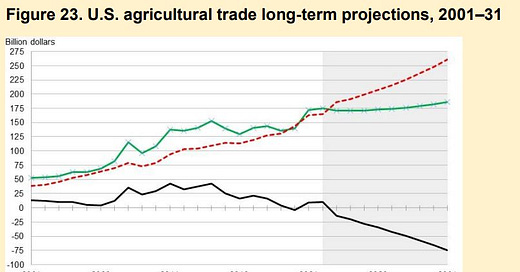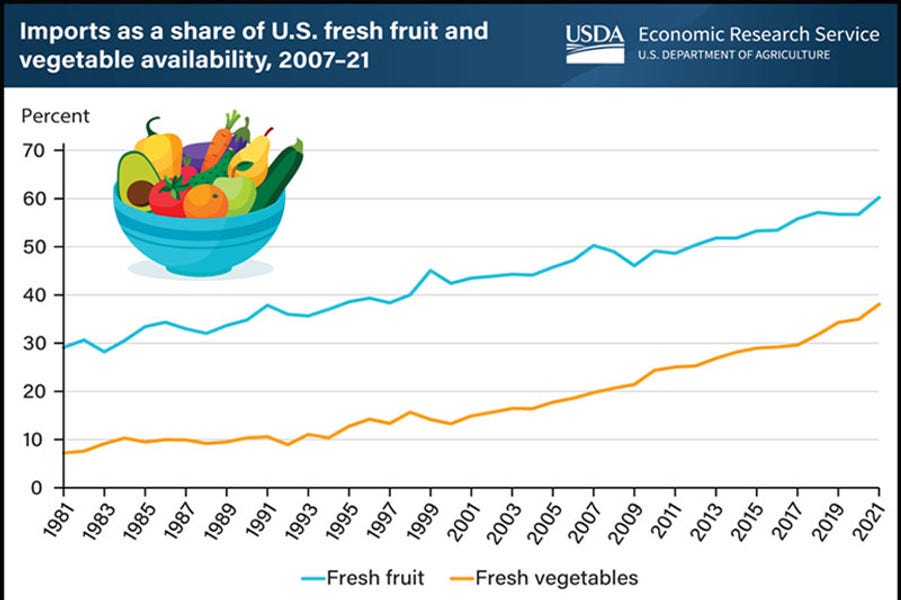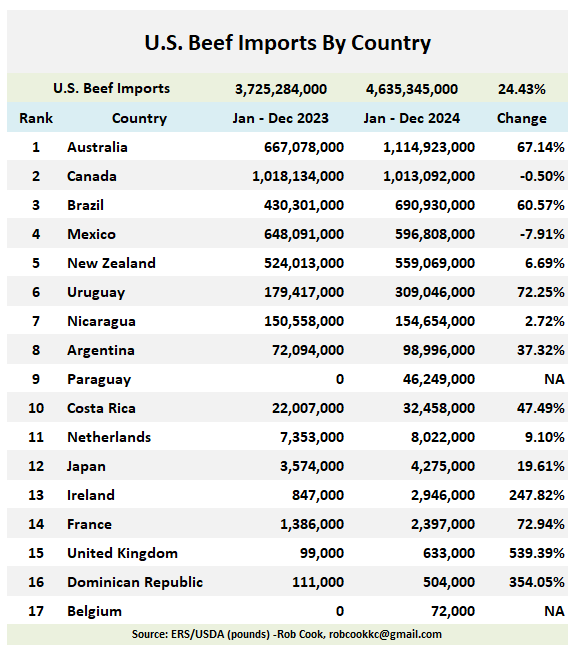As I have stated in a previous substack, the agricultural industry at the farm level is in dire straits. Very simply the profits are not there to keep people in the business of farming and ranching.
https://www.usda.gov/sites/default/files/documents/USDA-Agricultural-Projections-to-2031.pdf
Is this sustainable for a free country, or is it a future blueprint to the USA being controlled by a foreign enemy?
The above is a interesting read from the USDA and their outlook for food imports, for the USA and the world.
What Does This Mean for the Future?
The U.S. becoming a net food importer raises questions about long-term food security. A reliance on imported food can make the country more vulnerable to global supply chain disruptions, such as those experienced during the COVID-19 pandemic. Additionally, concerns have been raised about the environmental impacts of transporting large quantities of food over long distances, contributing to carbon emissions and other environmental challenges.
Moving forward, the U.S. may need to reconsider its agricultural priorities. Shifting more focus toward growing food for domestic consumption rather than producing commodities for export could help to address some of these concerns. Additionally, addressing the structural issues that contribute to the trade deficit, such as the strength of the dollar and competitive pressures from global markets, will be important for ensuring the sustainability of U.S. agriculture.
In conclusion, the shift from being a net food exporter to a net food importer signals a significant change in the U.S. food system. While it reflects the global nature of food production and consumption today, it also raises important questions about food security, trade policy, and the future of American agriculture.
Did we learn nothing with covid and supply chains? 30% of our vegetables and 60% of our fruit is imported. What happens if these countries have internal strife? droughts, floods? Labor strikes?
Meat imports
Beef 12% up 24% Year over year 2023-2024
https://www.statista.com/statistics/194702/us-total-beef-and-veal-imports-and-exports-since-2001/
Chicken less than 1%
The Poultry Site reports that projected broiler imports for 2024 were 178 million pounds, an increase of 47 million pounds from the 2023 total. Around a 50% increase.
Their is no report in statista that I can find on USA imports for poultry.
Pork 4.41% less than 1% increase 2023-2024
https://www.statista.com/statistics/194708/us-total-pork-imports-and-exports-since-2001/
Lamb 80% Their has been a total collapse of US lamb and mutton production.
https://www.statista.com/statistics/194707/us-total-lamb-and-mutton-imports-and-exports-since-2001/
https://www.r-calfusa.com/weekly-address-will-tariffs-arrive-in-time-to-save-american-lamb/
From 2012 through 2023, lamb consumption in America increased by more than 40%. Now a functional market would predict that domestic lamb production would likewise grow by about that same amount, but it certainly would not predict that domestic production would decline. But that’s exactly what happened, domestic lamb production fell nearly 17% while consumption grew more than 40%. So, there it is! A crystal-clearxample of severe market failure in an important domestic livestock industry.
Cattle are the next target for importers. Cattle men and women are on a knifes edge on profits and the government is actively against them.
Why has this happened to cattle and sheep? Neither can be easily housed in massive buildings like pigs and chickens. It takes a huge amount of land to raise them. Their is no way to effectively put them in buildings and feed them. Once you can building raise animals automation takes over for feed and water. The amount of land that must be covered to check on animals is huge for cattle and sheep vs hogs and chickens. Then we have predators, building raised vs pasture raised. Controlled environment vs no control environment.
Yes the feeder part of cattle and sheep are concentrated areas, but the animals birthing and the raising of them does not work in concentrated yards.
Land and labor are far cheaper in these importing countries.
https://www.r-calfusa.com/ranch-group-thankful-for-cattle-beef-and-lamb-tariffs/
Ranch Group Thankful for Cattle, Beef and Lamb Tariffs
For Immediate Release
Contact: R-CALF USA CEO Bill Bullard
Phone: 406-252-2516; r-calfusa@r-calfusa.com
Billings, Mont., April 2, 2025 – Today, R-CALF USA, the nation’s largest nonprofit trade association representing independent cattle and sheep producers, applauded President Trump’s universal 10 percent tariff on all imported goods stating that the tariffs are needed to reverse the ongoing and rapid contraction of both the U.S. cattle industry and sheep industry.
“Our nation’s cattle and sheep sectors are losing farms and ranches at an alarming rate, with census data showing our beef cattle operations disappeared at the rate of over 21,000 farms and ranches per year during the five-year period between the two latest censuses. Tariffs will help put an end to the globalists’ practice of using cheaper imports to reduce demand for domestic cattle and sheep, which causes domestic farms and ranches to fail,” said R-CALF USA CEO Bill Bullard.
R-CALF USA has been aggressively supporting livestock tariffs as legitimate economic tools to rebuild domestic livestock industries so America can remain near self-sufficient in the production of beef and lamb, two important protein sources for American diets.
The ranch group is also asking for tariff-rate quota systems to complement tariffs. Tariff-rate quotas are limits set on the volume of imported beef or lamb that can enter the U.S. market.
“Both our cattle and sheep industries need ‘space’ from the downward price pressure of cheaper imports to incentivize domestic herd expansions, investments in feedlots and packing facilities, and to attract new entrants into the industry,” Bullard said.
In recent letters to the Trump administration, R-CALF USA also asked for a tariff-rate quota system that would limit current beef imports by 1.5 billion pounds and substantially limit lamb imports to allow the domestic sheep industry to reclaim at least 50 percent of the domestic lamb market.
The ranch group also asked for a 25 percent tariff on imports of live cattle from Canada and Mexico.
“We’re thankful for today’s announcement and will continue working with the administration to achieve both volume limits on imports as well as higher tariffs on livestock imports,” Bullard concluded.
###
Ranchers Cattlemen Action Legal Fund United Stockgrowers of America (R-CALF USA) is the largest producer-only cattle trade association in the United States. It is a national, nonprofit organization dedicated to ensuring the continued profitability and viability of the U.S. cattle and sheep industries. For more information, visit www.r-calfusa.com or call 406-252-2516.
https://www.nationalbeefwire.com/beef-imports
This brings us to a possible solution. cattle and sheep ranchers need profits to grow and bring new people into the business. Are tariffs the solution? Maybe, the solution most certainly is not further wrecking our producers with low ball imports.
Tariffs or a outright import ban are the only solutions I see that can save these industries and they are not a sure bet. Either will end the cheap beef and mutton policies now in place. One thing for sure we cannot keep loosing ranchers and expect to eat beef and mutton. Any disruption in other countries that result in them banning exports means we do without. These other countries look out for themselves first vs the USA that the government sells out their producers at every turn.
The importation of fruits, vegetables and meat IS a national security issue. With the numbers above if they are not turned around we are looking at a dire future in food.
We have seen what happens to an industry that is drawn, quartered and gutted. Textiles are a good example. As late as the 1980’smost clothing was produced here in the states. The free trade agreements moved nearly all that over seas. We cannot make clothing, shoes or even towels - what happens if a war breaks out with China? What if China pushes the screw you button? We won’t even have clothing for our soldiers let alone us.
Is this what we want for food? The day is not far off when it could happen that shelves will be empty because of another plandemic or war. Look at that first chart. Now imagine the fruit and vegetable aisle in your store having 40-70% less in them. Yep pretty ugly.
Tariffs and import bans are a last resort to revive the meat animal sector on a nationwide basis. On a local basis find a farmer that produces meat and vegetables and fruit and buy locally. It may cost a little more but is that little more worth ensuring we have food producers? We have lost a huge amount of ranchers in the last 20 years. That knowledge base is now gone also. While I do raise cattle, chickens and have raised hogs I have never raised sheep. Each animals has its own specific needs and handling requirements. Some of this knowledge is only gained by raising the animal and getting a feel for them. In the case of sheep I do not know if that industry is salvageable as the number of people raising them is small. Cattle are not far behind nor are pigs. None of these are cheap to learn on how to raise them. Chickens are a little different. they are relatively cheap and loosing 25 -50 is not financially devastating vs cattle sheep or hogs.
Buying locally will not save the entire country it will however save your small area and if we have enough of these small areas in their entirety the US food system can be made more resilient and safer.
It will be interesting how this all shakes out. Hopefully they get straightened out and the USA starts feeding itself again.
My previous post on the dire straits the USA is in on food production
Dire Straits
Well the 2022 USDA Ag Census has been released and it is ugly for the future of the USA and its farmers and ranchers.








One silo of a larger problem.
The UniParty: Big Gov + Big Corp.
USA Inc puts profit over people.
I think the over reliance on property taxes put farmers and ranchers at a disadvantage. Move to consumption taxes would provide relief.